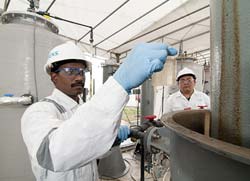Water purification unit generates its own energy

The pilot facility for this process, which is located at a site run by Singapore’s Public Utilities Board, has been operating in an energy- neutral manner since June 2010. Now, the city state is building a much larger pilot facility – one that will process 300 times more effluent than its predecessor, or about as much sewage water as is produced by around 1,000 people.
A typical urban biological water purification facility accommodates water from 10,000 to 100,000 residents. Today an aerobic (ventilated) process is used in which bacteria break down impurities in water by digesting them and converting them into new bacterial substances.
This produced bacteria flakes filled with impurities — forming sludge that is then separated and either deposited in landfills or burned. But the organic impurities contain ten times more energy than needed to do the cleaning itself. They can therefore be used to generate methane, which could be used in gas-fired power plants or combined heat-and-power plants. However, sludge concentrations in municipal sewage systems are too low to produce methane economically.
With this in mind, development engineers from Siemens Water Technologies have developed a technology for charging bacteria flakes with organic impurities for an extremely short time during ventilation. As a result, bacterial reproduction is minimized. After most of the water is separated, the bacteria ferment the impurities into methane in an anaerobic process step. After two aerobic steps and one anaerobic step, the sludge has been broken down so that the least possible amount of sludge remains and the largest possible amount of methane is available, as reported in the latest issue of the research magazine “Pictures of the Future”.
The pilot facility now in operation cleans around half a cubic meter of wastewater per day. A conventional water treatment plant requires a little less than 0.25 kilowatt-hours of energy to do this, so the pilot unit needs to generate roughly that amount of energy in the form of methane. A bigger facility could be run in an energy- neutral manner. Market launch of the technology is scheduled for 2012.
Media Contact
More Information:
http://www.siemens.com/researchnewsAll latest news from the category: Power and Electrical Engineering
This topic covers issues related to energy generation, conversion, transportation and consumption and how the industry is addressing the challenge of energy efficiency in general.
innovations-report provides in-depth and informative reports and articles on subjects ranging from wind energy, fuel cell technology, solar energy, geothermal energy, petroleum, gas, nuclear engineering, alternative energy and energy efficiency to fusion, hydrogen and superconductor technologies.
Newest articles

Superradiant atoms could push the boundaries of how precisely time can be measured
Superradiant atoms can help us measure time more precisely than ever. In a new study, researchers from the University of Copenhagen present a new method for measuring the time interval,…

Ion thermoelectric conversion devices for near room temperature
The electrode sheet of the thermoelectric device consists of ionic hydrogel, which is sandwiched between the electrodes to form, and the Prussian blue on the electrode undergoes a redox reaction…

Zap Energy achieves 37-million-degree temperatures in a compact device
New publication reports record electron temperatures for a small-scale, sheared-flow-stabilized Z-pinch fusion device. In the nine decades since humans first produced fusion reactions, only a few fusion technologies have demonstrated…





















